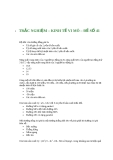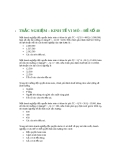
PRINCIPLE OF MICROECONOMICS INSTRUCTOR: MSc. NGUYEN VIET HOA
1
CHAPTER 6: MARKET STRUCTURE
PART 1: PERFECT COMPETITION
1. In a competitive market, the actions of any single buyer or seller will
A. have a negligible impact on the market price.
B. have little effect on overall production but will ultimately change final product price.
C. cause a noticeable change in overall production and a change in final product price.
D. adversely affect the profitability of more than one firm in the market.
2. If the firm doubles its output from 3 to 6 units, total revenue will
A. increase by less than $39.
B. increase by exactly $39.
C. increase by more than $39.
D. It cannot be determined from the information provided.
3. For a firm in a perfectly competitive market, the price of the good is always
A. equal to marginal revenue.
B. equal to total revenue.
C. greater than average revenue.
D. All of the above are correct.
4. If a firm in a perfectly competitive market triples the number of units of output sold,
then total revenue will
A. more than triple.
B. less than triple.
C. exactly triple.
D. All of the above are potentially true.
5. Because the goods offered for sale in a competitive market are largely the same,
A. there will be few sellers in the market.
B. there will be few buyers in the market.
C. buyers will have market power.
D. sellers will have little reason to charge less than the going market price.
6. Which of the following is NOT a characteristic of a perfectly competitive market?
A. Firms are price takers.
B. Firms have difficulty entering the market.
C. There are many sellers in the market.
D. Goods offered for sale are largely the same.
7. When firms are said to be price takers, it implies that if a firm raises its price,
A. buyers will go elsewhere.

PRINCIPLE OF MICROECONOMICS INSTRUCTOR: MSc. NGUYEN VIET HOA
2
B. buyers will pay the higher price in the short run.
C. competitors will also raise their prices.
D. firms in the industry will exercise market power.
8. Which of the following statements best reflects a price-taking firm?
A. If the firm were to charge more than the going price, it would sell none of its goods.
B. The firm has no incentive to charge less than the going price.
C. The firm can sell as much as it wants to sell at the going price.
D. All of the above are correct.
9. Competitive firms have
A. downward-sloping demand curves and they can sell as much output as they desire at
the market price.
B. downward-sloping demand curves and they can sell only a limited quantity of output
at each price.
C. horizontal demand curves and they can sell as much output as they desire at the market
price.
D. horizontal demand curves and they can sell only a limited quantity of output at each
price.
10. Of the following characteristics of competitive markets, which are necessary for
firms to be price takers?
(i) There are many sellers.
(ii) Firms can freely enter or exit the market.
(iii) Goods offered for sale are largely the same.
A. (i) and (ii) only
B. (i) and (iii) only
C. (ii) only
D. All are necessary.
11. When a firm in a competitive market receives $500 in total revenue, it has a
marginal revenue of $10. What is the average revenue, and how many units were sold?
A. $5 and 100
B. $10 and 50
C. $10 and 100
D. The answer cannot be determined from the information given.
12. If a firm in a competitive market reduces its output by 20 percent, then as a result
the price of its output is likely to
A. increase.

PRINCIPLE OF MICROECONOMICS INSTRUCTOR: MSc. NGUYEN VIET HOA
3
B. remain unchanged.
C. decrease by less than 20 percent.
D. decrease by more than 20 percent.
13. When a firm in a competitive market produces 10 units of output, it has a marginal
revenue of $8.00. What would be the firm’s total revenue when it produces 6 units of
output?
A. $4.80
B. $6.00
C. $48.00
D. $60.00
14. Changes in the output of a perfectly competitive firm, without any change in the
price of the product, will change the firm’s
A. total revenue.
B. marginal revenue.
C. average revenue.
D. All of the above are correct.
15. When a profit-maximizing firm in a competitive market has zero economic profit,
accounting profit
A. is negative (accounting losses).
B. is positive.
C. is also zero.
D. could be positive, negative or zero.
16. In a competitive market,
A. no single buyer or seller can influence the price of the product.
B. there is a small number of sellers.
C. the goods offered by the different sellers are markedly different.
D. All of the above are correct.
17. In a competitive market,
A. each seller can sell all he wants to sell at the going price.
B. buyers and sellers are price takers.
C. the goods offered by the different sellers are largely the same.
D. All of the above are correct.
18. If ABC Company sells its product in a competitive market, then
A. the price of that product depends on the quantity of the product that ABC Company
produces and sells.

PRINCIPLE OF MICROECONOMICS INSTRUCTOR: MSc. NGUYEN VIET HOA
4
B. ABC Company’s total revenue is proportional to its quantity of output.
C. ABC Company’s total cost is proportional to its quantity of output.
D. ABC Company’s total revenue is equal to its average revenue.
19. For a competitive firm,
A. Total revenue = Average revenue.
B. Total revenue = Marginal revenue.
C. Total cost = Marginal revenue.
D. Average revenue = Marginal revenue.
20. For a competitive firm,
A. average revenue equals the price of the good, but marginal revenue is different.
B. marginal revenue equals the price of the good, but average revenue is different.
C. average revenue equals marginal revenue, but the price of the good is different.
D. average revenue, marginal revenue, and the price of the good are all equal to one
another.
21. If a competitive firm is (i) selling 1,000 units of its product at a price of $9 per unit
and (ii) earning a positive profit, then
A. its total cost is less than $9,000.
B. its marginal revenue is less than $9.
C. its average revenue is greater than $9.
D. All of the above are correct.
22. The Wheeler Wheat Farm sells wheat to a grain broker in Seattle, Washington.
Since the market for wheat is generally considered to be competitive, the Wheeler
Wheat Farm maximizes its profit by choosing
A. to produce the quantity at which average total cost is minimized.
B. to produce the quantity at which average fixed cost is minimized.
C. to sell its wheat at a price where marginal cost is equal to average total cost.
D. the quantity at which market price is equal to the farm’s marginal cost of production.
23. When price is greater than marginal cost for a firm in a competitive market,
A. marginal cost must be falling.
B. the firm must be minimizing its losses.
C. there are opportunities to increase profit by increasing production.
D. the firm should decrease output to maximize profit.
24. Firms that shut down in the short run still have to pay their
A. variable costs.
B. fixed costs.

PRINCIPLE OF MICROECONOMICS INSTRUCTOR: MSc. NGUYEN VIET HOA
5
C. total cost.
D. All of the above are correct.
25. The short-run supply curve for a firm in a perfectly competitive market is
A. likely to be horizontal.
B. likely to slope downward.
C. determined by forces external to the firm.
D. its marginal cost curve (above average variable cost).
26. A competitive firm’s marginal cost curve is regarded as its supply curve because
A. the position of the marginal cost curve determines the price for which the firm should
sell its product.
B. among the various cost curves, the marginal cost curve is the only one that slopes
upward.
C. the marginal cost curve determines the quantity of output the firm is willing to supply
at any price.
D. the firm is aware that marginal revenue must exceed marginal cost in order for profit
to be maximized.
27. When a perfectly competitive firm makes a decision to shut down,
A. marginal cost is above average variable cost.
B. marginal cost is above average total cost.
C. price is below the minimum of average variable cost.
D. fixed costs exceed variable costs.
28. When total revenue is less than variable costs, a firm in a competitive market will
A. continue to operate as long as average revenue exceeds marginal cost.
B. continue to operate as long as average revenue exceeds average fixed cost.
C. shut down.
D. always exit the industry.
29. When price is below average variable cost, a firm in a competitive market will
A. shut down and incur fixed costs.
B. shut down and incur both variable and fixed costs.
C. continue to operate as long as average revenue exceeds marginal cost.
D. continue to operate as long as average revenue exceeds average fixed cost.
30. In 1999, sheepherders in the western United States slaughtered 10,000 sheep and
buried them in large open pits rather than truck them to the market to be sold. This
behavior is most likely explained by



![Trắc nghiệm Kinh tế vi mô: Bộ sưu tập [mới nhất]](https://cdn.tailieu.vn/images/document/thumbnail/2014/20140618/mimilui/135x160/1690681_147.jpg)
![Trắc nghiệm Kinh tế vi mô: Tuyển tập bài tập [kèm đáp án]](https://cdn.tailieu.vn/images/document/thumbnail/2014/20140529/langtuthangpro/135x160/1683239_046.jpg)
![16 đề thi trắc nghiệm Kinh tế vi mô [có đáp án]](https://cdn.tailieu.vn/images/document/thumbnail/2014/20140529/langtuthangpro/135x160/5871401321640.jpg)
![Slide trắc nghiệm kinh tế vi mô [mới nhất]](https://cdn.tailieu.vn/images/document/thumbnail/2013/20131006/kugin293/135x160/3181381051497.jpg)
![Trắc Nghiệm Kinh Tế Vi Mô: Tổng Hợp Môn Học [Năm Hiện Tại]](https://cdn.tailieu.vn/images/document/thumbnail/2013/20130619/nhungmuadauyeu123/135x160/5801371636125.jpg)


![Trắc nghiệm Kinh tế vi mô: Đề số 39 [Kèm đáp án chi tiết]](https://cdn.tailieu.vn/images/document/thumbnail/2013/20130530/tramoi_1/135x160/4121369874715.jpg)















